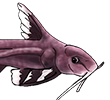Hey,
me once more, to clarify some points I mentioned in my description but wasn´t able to visualize accordingly "back then":

This is a picture of two Pseudacanthicus sp. "3" I am almost certain to be a couple although not totally mature yet (they should be at the brink of sexual maturity). The fish are roughly 13 and 15cm in size, the right one being the larger (which is good, because the other way round you might wonder if it didn´t develop the visible differences yet). Unfortunately, I wasn´t able to get decent pictures with erect dorsal fin, thus you´ll have to trust me in saying that they are clearly different in size.
What is cleary visible, however, are four differences:
Headshape: admittedly, is hardly discernible and probably only visible it you want to see it, but to me they start to become discernible and will be even more so in the years to come.
Size of paired fins: compare the paired fins of both fish: those of the left fish are significantly longer and larger. This fits to fin in Pseudacanthicus being bigger in general and in this special case might be helpful in tending eggs. Especially the pelvic fins are enlarged.
"Spinyness": is a little bit difficult to see in such a necessarily downsized picture, but what should be apparent is the fact that the right fishs flanks are only covered with Odontodes up to about the pelvic fins, while the left fish is spiny up to the head. Also, Odontodes are visible at the edge of the snout, which are hardly visible in the right hand one. In general, the Odontodes in the left fish are significantly longer and by far more numerous, see, for example, the pectoral fin spine.
Bodyshape: the overall impression of the right fish is more rounded and significantly broader around the girdle (that the right word?). This should not be linked to differences in feeding habits, since both fish are kept in the same tank under identical conditions and they are neither particularly slender nor unusual fat.
The question remains now, of course, how present these differences (remember: they are not totally mature yet, thus differences not fully developed up to now!) are in L 25-type Pseudacanthicus. I personally believe (with little more than pure intuition), that almost all such differences should be present in those, as well, but with less clearity.
And, as always, if you have clearly visible differences within your group, it´s easier to tell what a significant difference looks like and what´s usual interspecific variability..
Hope that unclouded a few things (though probably not particularly helpful in this very case),
Cheers, Sandor
"What gets us into trouble is not what we don´t know.
It´s what we know for sure that just ain´t so."
--Mark Twain







